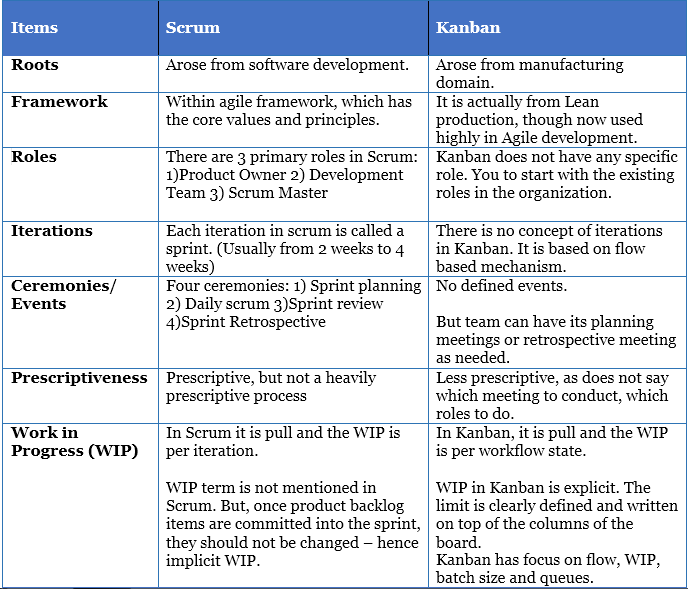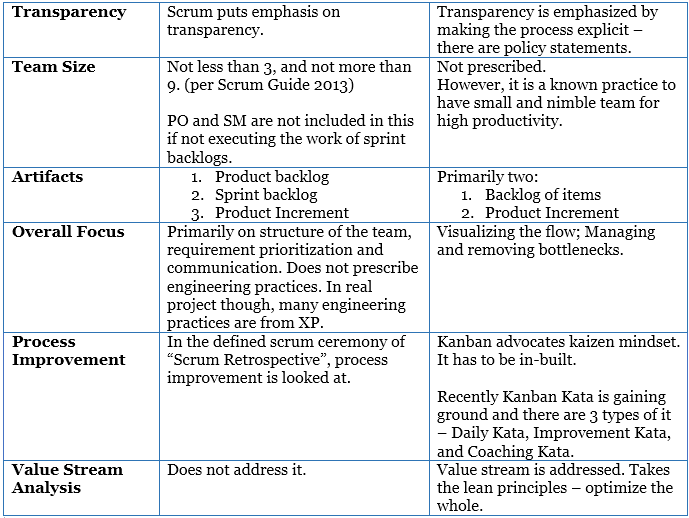[NEW: ACP Exam Prep Book Available - "I Want To Be An ACP" (Link)]
Takeaway: Scrum has seen wide adoption in the agile world. In recent years, Kanban, a mechanism taken from Toyota Production System (TPS), has been gaining popularity. Scrum Alliance's state of scrum report 2015 states that 42% respondents use Scrum exclusively and 43% combines Scrum with Kanban. Also, in the new edition of PMI's Agile Certified Practitioner (ACP) exam from 2015, Kanban has been emphasized. In this post, I seek to outline the various similarities and difference between Scrum and Kanban.
In my PMI-ACP and other Agile related sessions, I get a number of questions on Kanban. In fact, in my earlier post on PMI-ACP new exam, I wrote:
“In past few years, a trend has been visible: Scrum is the most used one; Kanban is being used more now; however, organizations mostly follow their way of Agile implementation. The last one is interesting! Few follow Agile or Scrum or Kanban practices by the book per se, rather it is mostly customized as per the need of the organization.”
The scrum report of 2015 shows some interesting data. Though it does not show how many use “only” Kanban (logically it would not, as the report is for Scrum), I believe many organizations use Kanban while going for Agile implementation.
 |
| Data Source – State of Scrum Report, 2015 from ScrumAlliance |
So, what are Kanban and Scrum?
Complete description of them is beyond the scope of this article. I’ll provide a brief summary.
Kanban is a Japanese term taken from TPS, which means “visual card” or “signaling card” or “signboard”. Toyota used Kanban cards to trigger pull and limit the amount of work under progress. There are 3 key principles of Kanban: [v.i.z] visualize the workflow, limit work in progress (WIP) and manage the workflow. There are some more principles, which have been derived by proponents of Kanban. However, the mentioned three are the key ones.
Scrum, which is by far the most used framework, provides an iterative and incremental approach to product development. In every iteration - called sprint – a set of features are taken up by team and then delivered at the end of iteration. Well, to be precise, "potentially releasable" version of the product. There are certain key ceremonies which one has to follow and there are prescribed artifacts which should be available.
Now, let us look at the similarities and differences. I have seen similarities and differences help. Hence, taking that approach. The list, of course, is not exhaustive. There can be others.
Similarities: Scrum and Kanban
As noted in my earlier post, PMI-ACP exam has changed, there has been certain focus on Kanban.
“For the new PMI-ACP exam, the reference book list has changed and quite a few new book have been added – especially for Kanban – perhaps matching the trends in the Agile world.”
It is important that you understand the concepts of both Scrum and Kanban to do well in the exam. Hence this post and believe it will help in your preparation.
Book for ACP exam:
You may also like:
- PMI-ACP Prep: Scrum Sprint I/O (Inputs and Outputs)
- My Experience – PMI ACP Examination
- 30 Free Questions on PMI-ACP Examination (Part - 1)
- 30 Free Questions on PMI-ACP Examination (Part - 2)
- Changing PMI-ACP Exam in 2015: What is New and What Has Changed? (1)
- Changing PMI-ACP Exam in 2015: What is New and What Has Changed? (2)




No comments:
Post a Comment
Sign- or Log-in and put your name while asking queries in comments. Any comment is welcome - comments, review or criticism. But off-topic, abusive, defamatory comments will be moderated or may be removed.